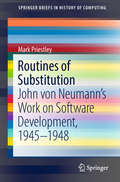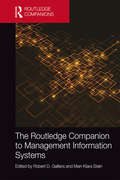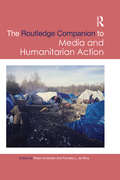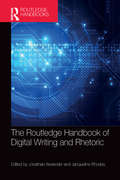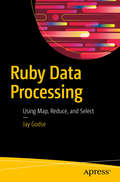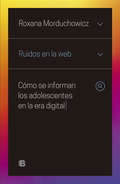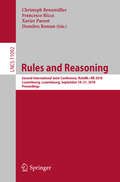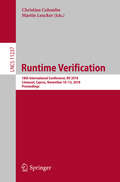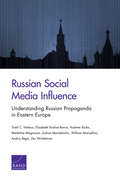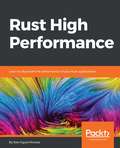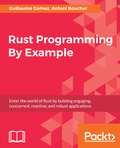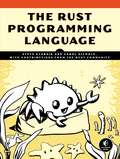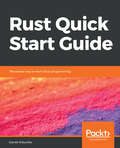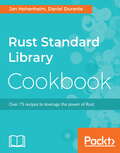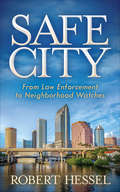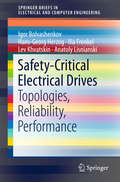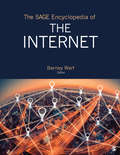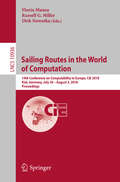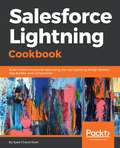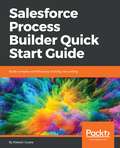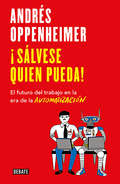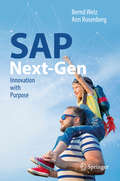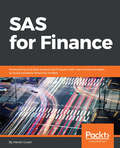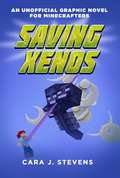- Table View
- List View
Routines of Substitution: John Von Neumann's Work On Software Development, 1945-1948 (Springerbriefs In History Of Computing Ser.)
by Mark PriestleyThis work is a historical and philosophical study of the programming work carried out by John von Neumann in the period 1945-8. At the heart of the book is an examination of a manuscript featuring the earliest known surviving example of von Neumann’s coding, a routine written in 1945 to ‘mesh’ two sequences of data and intended to be part of a larger program implementing the algorithm now known as mergesort. The text of the manuscript itself, along with a preliminary document describing the code he used to write this program, are reproduced as appendices. The program is approached in three chapters describing the historical background to von Neumann’s work, the significance of the sorting application itself, and the development of the EDVAC, the machine for which the program was written. The subsequent chapters widen the focus again, discussing the subsequent evolution of the program and the crucial topic of subroutines, before concluding by situating von Neumann’s work in a number of wider contexts. The book also offers a unifying philosophical interpretation of von Neumann’s approach to coding.
The Routledge Companion to Management Information Systems (Routledge Companions in Business, Management and Accounting)
by Robert D. Galliers Mari-Klara SteinThe field of Information Systems has been evolving since the first application of computers in organizations in the early 1950s. Focusing on information systems analysis and design up to and including the 1980s, the field has expanded enormously, with our assumptions about information and knowledge being challenged, along with both intended and unintended consequences of information technology. This prestige reference work offers students and researchers a critical reflection on major topics and current scholarship in the evolving field of Information Systems. This single-volume survey of the field is organized into four parts. The first section deals with Disciplinary and Methodological Foundations. The second section deals with Development, Adoption and Use of MIS – topics that formed the centrepiece of the field of IS in the last century. The third section deals with Managing Organizational IS, Knowledge and Innovation, while the final section considers emerging and continuing issues and controversies in the field – IS in Society and a Global Context. Each chapter provides a balanced overview of current knowledge, identifying issues and discussing relevant debates. This prestigious book is required reading for any student or researcher in Management Information Systems, academics and students covering the breadth of the field, and established researchers seeking a single-volume repository on the current state of knowledge, current debates and relevant literature.
Routledge Companion to Media and Humanitarian Action (Routledge Media and Cultural Studies Companions)
by Robin Andersen Purnaka L. De SilvaIn this moment of unprecedented humanitarian crises, the representations of global disasters are increasingly common media themes around the world. The Routledge Companion to Media and Humanitarian Action explores the interconnections between media, old and new, and the humanitarian challenges that have come to define the twenty-first century. Contributors, including media professionals and experts in humanitarian affairs, grapple with what kinds of media language, discourse, terms, and campaigns can offer enough context and background knowledge to nurture informed global citizens. Case studies of media practices, content analysis and evaluation of media coverage, and representations of humanitarian emergencies and affairs offer further insight into the ways in which strategic communications are designed and implemented in field of humanitarian action.
The Routledge Handbook of Digital Writing and Rhetoric (Routledge Handbooks in Communication Studies)
by Jonathan Alexander and Jacqueline RhodesThis handbook brings together scholars from around the globe who here contribute to our understanding of how digital rhetoric is changing the landscape of writing. Increasingly, all of us must navigate networks of information, compose not just with computers but an array ofmobile devices, increase our technological literacy, and understand the changing dynamics of authoring, writing, reading, and publishing in a world of rich and complex texts. Given such changes, and given the diverse ways in which younger generations of college students are writing, communicating, and designing texts in multimediated, electronic environments, we need to consider how the very act of writing itself is undergoing potentially fundamental changes. These changes are being addressed increasingly by the emerging field of digital rhetoric, a field thatattempts to understand the rhetorical possibilities and affordances of writing, broadly defined, in a wide array of digital environments. Of interest to both researchers and students, this volume provides insights about the fields of rhetoric, writing, composition, digital media, literature, and multimodal studies.
Ruby Data Processing
by Jay GodseGain the basics of Ruby’s map, reduce, and select functions and discover how to use them to solve data-processing problems. This compact hands-on book explains how you can encode certain complex programs in 10 lines of Ruby code, an astonishingly small number. You will walk through problems and solutions which are effective because they use map, reduce, and select. As you read Ruby Data Processing, type in the code, run the code, and ponder the results. Tweak the code to test the code and see how the results change. After reading this book, you will have a deeper understanding of how to break data-processing problems into processing stages, each of which is understandable, debuggable, and composable, and how to combine the stages to solve your data-processing problem. As a result, your Ruby coding will become more efficient and your programs will be more elegant and robust. What You Will LearnDiscover Ruby data processing and how to do it using the map, reduce, and select functionsDevelop complex solutions including debugging, randomizing, sorting, grouping, and moreReverse engineer complex data-processing solutionsWho This Book Is For Those who have at least some prior experience programming in Ruby and who have a background and interest in data analysis and processing using Ruby.
Ruidos en la web: Cómo se informan los adolescentes en la era digital
by Roxana MorduchowiczEste es un libro sobre los adolescentes. También sobre las tecnologías. Y sobre ciudadanía y política. Desde estos cuatro ejes y analiza las serias dificultades que tienen los jóvenes para buscar, procesar, seleccionar, evaluar y utilizar el enorme caudal de información que circula hoy en internet. Adolescencia, tecnología, educación y cultura ciudadana: sobre estos cuatro ejes se asienta Ruidos en la web para explorar un interrogante crucial: cómo se informan los jóvenes en un universo de saberes sin límites. La pregunta es asediada a partir de múltiples enfoques: desde la forma en que los chicos utilizan internet para las tareas escolares, los nuevos hábitos propios de esta era tecnológica, su impacto en el espacio doméstico, el cambio en el concepto de autoridad cuando se trata de acudir a una fuente de información, la dificultad para distinguir entre contenidos falsos y genuinos. Y de esta problemática se desprende la preocupación por el modo en que se está formando la futura dirigencia y sus consecuencias sobre la democracia. Con un estilo ameno que no va en desmedro del rigor académico, Roxana Morduchowicz, especialista en cultura juvenil y en la relación de los chicos con las pantallas e internet, brinda un panorama de la situación, desmitifica postulados poco consistentes, se resiste a los clichés y pone en agenda un tema de interés universal.
Rules and Reasoning: Second International Joint Conference, RuleML+RR 2018, Luxembourg, Luxembourg, September 18–21, 2018, Proceedings (Lecture Notes in Computer Science #11092)
by Christoph Benzmüller Francesco Ricca Xavier Parent Dumitru RomanThis book constitutes the proceedings of the International Joint Conference on Rules and Reasoning, RuleML+RR 2018, held in Luxembourg during September 2018. This is the second conference of a new series, joining the efforts of two existing conference series, namely “RuleML” (International Web Rule Symposium) and “RR” (Web Reasoning and Rule Systems).The 10 full research papers presented together with 5 long technical communications and 7 short papers were carefully reviewed and selected from 33 submissions.
Runtime Verification: 18th International Conference, RV 2018, Limassol, Cyprus, November 10–13, 2018, Proceedings (Lecture Notes in Computer Science #11237)
by Christian Colombo Martin LeuckerThis book constitutes the refereed proceedings of the 18th International Conference on Runtime Verification, RV 2018, held in Limassol, Cyprus, in November 2018. The 21 full papers presented together with 3 short papers and 3 tool papers were carefully reviewed and selected from 49 submissions. The RV conference is concerned with all aspects of monitoring and analysis of hardware, software and more general system executions. Runtime verification techniques are lightweight techniques to assess correctness, reliability, and robustness; these techniques are significantly more powerful and versatile than conventional testing, and more practical than exhaustive formal verification.Chapter “Hardware-based Runtime Verification with Embedded Tracing Units and Stream Processing” is available open access under a Creative Commons Attribution 4.0 International License via link.springer.com.
Russian Social Media Influence: Understanding Russian Propaganda in Eastern Europe
by Todd C. Helmus Andrew Radin Zev Winkelman William Marcellino Andriy Bega Elizabeth Bodine-Baron Madeline Magnuson Joshua MendelsohnRussia employs a sophisticated social media campaign against former Soviet states that includes news tweets, nonattributed comments on web pages, troll and bot social media accounts, and fake hashtag and Twitter campaigns. Nowhere is this threat more tangible than in Ukraine. Researchers analyzed social media data and conducted interviews with regional and security experts to understand the critical ingredients to countering this campaign.
Rust High Performance: Learn to skyrocket the performance of your Rust applications
by Iban Eguia MorazaFind bottlenecks, identify the proper algorithm to use, optimize performance, and create really efficient Rust applicationsKey Features Understand common performance pitfalls and improve the performance of your applications. Get to grips with parallel programming and multithreading with Rust. Learn metaprogramming in Rust.Book DescriptionAt times, it is difficult to get the best performance out of Rust. This book teaches you to optimize the speed of your Rust code to the level of languages such as C/C++. You'll understand and fix common pitfalls, learn how to improve your productivity by using metaprogramming, and speed up your code by concurrently executing parts of it safely and easily. You will master the features of the language which will make you stand out and use them to really improve the efficiency of your algorithmsThe book begins with a gentle introduction to help you identify bottlenecks when programming in Rust. We highlight common performance pitfalls, along with strategies to detect and resolve these issues early. We move on to mastering Rust's type system, which will enable us to create impressive optimizations in both performance and safety at compile time. You will then learn how to effectively manage memory in Rust, mastering the borrow checker. We move on to measuring performance and you will see how this affects the way you write code. Moving ahead, you will perform metaprogramming in Rust to boost the performance of your code and your productivity. You will finally learn parallel programming in Rust, which enables efficient and faster execution by using multithreading and asynchronous programming.What you will learn Master tips and tricks to make your code faster. Learn how to identify bottlenecks in your Rust applications Discover how to profile your Rust software. Understand the type system to create compile-time optimizations. Master the borrow checker . Learn metaprogramming in Rust to avoid boilerplate code. Discover multithreading and work stealing in Rust. Understand asynchronous programming in Rust.Who this book is forThis book is for Rust developers keen to improve the speed of their code or simply to take their skills to the next level.
Rust Programming By Example: Enter the world of Rust by building engaging, concurrent, reactive, and robust applications
by Sebastian Dröge Daniel Durante Antoni Boucher Guillaume GomezDiscover the world of Rust programming through real-world examples Key Features Implement various features of Rust to build blazingly fast applications Learn to build GUI applications using Gtk-rs Explore the multi-threading aspect of Rust to tackle problems in concurrency and in distributed environments Book Description Rust is an open source, safe, concurrent, practical language created by Mozilla. It runs blazingly fast, prevents segfaults, and guarantees safety. This book gets you started with essential software development by guiding you through the different aspects of Rust programming. With this approach, you can bridge the gap between learning and implementing immediately. Beginning with an introduction to Rust, you’ll learn the basic aspects such as its syntax, data types, functions, generics, control flows, and more. After this, you’ll jump straight into building your first project, a Tetris game. Next you’ll build a graphical music player and work with fast, reliable networking software using Tokio, the scalable and productive asynchronous IO Rust library. Over the course of this book, you’ll explore various features of Rust Programming including its SDL features, event loop, File I/O, and the famous GTK+ widget toolkit. Through these projects, you’ll see how well Rust performs in terms of concurrency—including parallelism, reliability, improved performance, generics, macros, and thread safety. We’ll also cover some asynchronous and reactive programming aspects of Rust. By the end of the book, you’ll be comfortable building various real-world applications in Rust. What you will learn Compile and run the Rust projects using the Cargo-Rust Package manager Use Rust-SDL features such as the event loop, windows, infinite loops, pattern matching, and more Create a graphical interface using Gtk-rs and Rust-SDL Incorporate concurrency mechanism and multi-threading along with thread safety and locks Implement the FTP protocol using an Asynchronous I/O stack with the Tokio library Who this book is for This book is for software developers interested in system level and application programming who are looking for a quick entry into using Rust and understanding the core features of the Rust Programming. It’s assumed that you have a basic understanding of Java, C#, Ruby, Python, or JavaScript.
The Rust Programming Language
by Steve Klabnik Carol NicholsThe Rust Programming Language is the official book on Rust, an open-source, community-developed systems programming language that runs blazingly fast, prevents segfaults, and guarantees thread safety. This is the undisputed go-to guide to Rust, written by two members of the Rust core team, with feedback and contributions from 42 members of the community. The book assumes that you’ve written code in another programming language but makes no assumptions about which one, meaning the material is accessible and useful to developers from a wide variety of programming backgrounds. <P><P>Known by the Rust community as “The Book,” The Rust Programming Language includes concept chapters, where you’ll learn about a particular aspect of Rust, and project chapters, where you’ll apply what you’ve learned so far to build small programs. <P> The Book opens with a quick hands-on project to introduce the basics then explores key concepts in depth, such as ownership, the type system, error handling, and fearless concurrency. Next come detailed explanations of Rust-oriented perspectives on topics like pattern matching, iterators, and smart pointers, with concrete examples and exercises--taking you from theory to practice. The Rust Programming Language will also show you how to:- Grasp important concepts unique to Rust, like ownership, borrowing, and lifetimes- Use Cargo, Rust’s built-in package manager, to build and maintain your code, including downloading and building dependencies- Effectively use Rust’s zero-cost abstractions and employ your own You’ll learn to develop reliable code that’s speed and memory efficient, while avoiding the infamous and arcane programming pitfalls common at the systems level. When you need to dive down into lower-level control, this guide will show you how without taking on the customary risk of crashes or security holes and without requiring you to learn the fine points of a fickle toolchain. You’ll also learn how to create command line programs, build single- and multithreaded web servers, and much more. The Rust Programming Language fully embraces Rust’s potential to empower its users. This friendly and approachable guide will help you build not only your knowledge of Rust but also your ability to program with confidence in a wider variety of domains.
Rust Quick Start Guide: The easiest way to learn Rust programming
by Daniel ArbuckleGet familiar with writing programs in the trending new systems programming language that brings together the powerful performance of low-level languages with the advanced features like thread safety in multi-threaded codeKey FeaturesLearn the semantics of Rust, which can be significantly different from other programming languagesUnderstand clearly how to work with the Rust compiler which strictly enforces rules that may not be obviousExamples and insights beyond the Rust documentationBook DescriptionRust is an emerging programming language applicable to areas such as embedded programming, network programming, system programming, and web development. This book will take you from the basics of Rust to a point where your code compiles and does what you intend it to do!This book starts with an introduction to Rust and how to get set for programming, including the rustup and cargo tools for managing a Rust installation and development workflow.Then you'll learn about the fundamentals of structuring a Rust program, such as functions, mutability, data structures, implementing behavior for types, and many more. You will also learn about concepts that Rust handles differently from most other languages.After understanding the Basics of Rust programming, you will learn about the core ideas, such as variable ownership, scope, lifetime, and borrowing. After these key ideas, you will explore making decisions in Rust based on data types by learning about match and if let expressions. After that, you'll work with different data types in Rust, and learn about memory management and smart pointers.What you will learnInstall Rust and write your first program with itUnderstand ownership in RustHandle different data typesMake decisions by pattern matchingUse smart pointersUse generic types and type specializationWrite code that works with many data typesTap into the standard libraryWho this book is forThis book is for people who are new to Rust, either as their first programming language or coming to it from somewhere else. Familiarity with computer programming in any other language will be helpful in getting the best out of this book.
Rust Standard Library Cookbook: Over 75 recipes to leverage the power of Rust
by Daniel Durante Jan Nils FernerExplore the Rust Standard library and compose algorithms with minimal dependency on external librariesKey Features Develop high-quality, fast, and portable applications by leveraging the power of Rust's Standard library. Practical recipes that will help you work with the Standard library to boost your productivity as a Rust developer. Learn about most relevant external crates to be used along with the Standard library.Book DescriptionMozilla’s Rust is gaining much attention with amazing features and a powerful library. This book will take you through varied recipes to teach you how to leverage the Standard library to implement efficient solutions.The book begins with a brief look at the basic modules of the Standard library and collections. From here, the recipes will cover packages that support file/directory handling and interaction through parsing. You will learn about packages related to advanced data structures, error handling, and networking. You will also learn to work with futures and experimental nightly features. The book also covers the most relevant external crates in Rust. By the end of the book, you will be proficient at using the Rust Standard library.What you will learn How to use the basic modules of the library: strings, command line access, and more. Implement collections and folding of collections using vectors, Deque, linked lists, and more. Handle various file types , compressing and decompressing data. Search for files with glob patterns. Implement parsing through various formats such as CSV, TOML, and JSON. Utilize drop trait , the Rust version of destructor. Resource locking with Bilocks.Who this book is forThis book is for developers who would like to explore the power of Rust and learn to use the STL for various functionalities. A basic Rust programming knowledge is assumed.
Safe City: From Law Enforcement to Neighborhood Watches
by Robert HesselIt's a basic human right to feel and be safe in your communitywhere you live, work and play. But, few people know or understand everything it takes to make this possible. Safe City details the concerted effort and integration of new technology it takes to make communities safer for everyone.From fire departments detecting fires within seconds with thermal imaging to police departments detecting gunfire immediately through gunshot detection sensors, technology continues to evolve daily. Even surveillance cameras have taken great strides from the grainy images of years past, and just one camera can make a difference (read about how police identified the Boston Marathon bombers through a department stores video camera inside!). Safe City teaches the public how to harden targets and protect their homes, businesses, communities, themselves, and their loved ones. It takes a community effort to help reduce and prevent crime, and Safe City answers the questions people have along with pointing out many more that should be asked.,
Safety-Critical Electrical Drives: Topologies, Reliability, Performance (SpringerBriefs in Electrical and Computer Engineering)
by Anatoly Lisnianski Lev Khvatskin Ilia Frenkel Hans-Georg Herzog Igor BolvashenkovThis book focuses on one of the most important aspects of electrical propulsion systems – the creation of highly reliable safety-critical traction electrical drives. It discusses the methods and models for analysis and optimization of reliability and fault tolerance indices, based on which, it proposes and assesses methods for improving the availability, fault tolerance and performance of traction electric drives.
The SAGE Encyclopedia of the Internet
by Barney WarfThe Internet needs no introduction, and its significance today can hardly be exaggerated. Today, more people are more connected technologically to one another than at any other time in human existence. For a large share of the world’s people, the Internet, text messaging, and various other forms of digital social media such as Facebook have become thoroughly woven into the routines and rhythms of daily life. The Internet has transformed how we seek information, communicate, entertain ourselves, find partners, and, increasingly, it shapes our notions of identity and community. The SAGE Encyclopedia of the Internet addresses the many related topics pertaining to cyberspace, email, the World Wide Web, and social media. Entries will range from popular topics such as Alibaba and YouTube to important current controversies such as Net neutrality and cyberterrorism. The goal of the encyclopedia is to provide the most comprehensive collection of authoritative entries on the Internet available, written in a style accessible to academic and non-academic audiences alike.
The SAGE Encyclopedia of the Internet
by Barney WarfThe Internet needs no introduction, and its significance today can hardly be exaggerated. Today, more people are more connected technologically to one another than at any other time in human existence. For a large share of the world’s people, the Internet, text messaging, and various other forms of digital social media such as Facebook have become thoroughly woven into the routines and rhythms of daily life. The Internet has transformed how we seek information, communicate, entertain ourselves, find partners, and, increasingly, it shapes our notions of identity and community. The SAGE Encyclopedia of the Internet addresses the many related topics pertaining to cyberspace, email, the World Wide Web, and social media. Entries will range from popular topics such as Alibaba and YouTube to important current controversies such as Net neutrality and cyberterrorism. The goal of the encyclopedia is to provide the most comprehensive collection of authoritative entries on the Internet available, written in a style accessible to academic and non-academic audiences alike.
Sailing Routes in the World of Computation: 14th Conference on Computability in Europe, CiE 2018, Kiel, Germany, July 30 – August 3, 2018, Proceedings (Lecture Notes in Computer Science #10936)
by Florin Manea Russell G. Miller Dirk NowotkaThis book constitutes the refereed proceedings of the 14th Conference on Computability in Europe, CiE 2018, held in Kiel, Germany, in July/ August 2017.The 26 revised full papers were carefully reviewed and selected from 55 submissions. In addition, this volume includes 15 invited papers. The conference CiE 2018 has six special sessions, namely: Approximation and optimization, Bioinformatics and bio-inspired computing, computing with imperfect information, continuous computation, history and philosophy of computing (celebrating the 80th birthday of Martin Davis), and SAT-solving.
Salesforce Lightning Cookbook: Build modern enterprise apps using the new Lightning Design System, App Builder, and Components
by Syed Chand ShahOver 25 recipes to help you design and test informative applications on the Salesforce Lightning platformKey FeaturesLearn Salesforce Lightning concepts from scratch.Build scalable enterprise apps with Salesforce design guidelines and the CSS frameworkUse Visualforce to build custom user interfaces for mobile and web appsBook DescriptionThe new Lightning Experience combines three major components—Lightning Design System, Lightning App Builder, and Lightning Components—to enable anyone to quickly and easily create beautiful, modern enterprise apps. If you wish to meet the challenges that Lightning throws at you head-on, then look no further because this practical book will be your faithful companion and ensure that you make best use of the Lightning platform.The book starts by walking you through the three major Lightning Components and helps you enable and configure a Lightning solution. You will explore the art of working with standard components and build a basic layout for the application. Then, you will add more advanced components using the Lightning Framework. Finally, you will also build and migrate reports and dashboards to make your app look more professional. Towards the end of the book, you’ll make use of Design System to work with Salesforce data and lay out the entire page with the components that you’ve built, before integrating Visualforce in your application.What you will learnEnable and configure a Lightning solutionCreate standard Lightning solutions and build a basic page layoutAdd custom components to your Lightning pagesBuild and migrate reports and dashboardsIntegrate Lightning pages with Visualforce to enhance performanceAdd stunning custom designs and styling with Lightning Design SystemWho this book is forThis book is ideal for Salesforce developers, admins, sales consultants, and sales managers who are comfortable with using Lightning features to build basic apps. Experience with JavaScript, CSS, and HTML would be an advantage but not compulsory.
Salesforce Process Builder Quick Start Guide: Build complex workflows by clicking, not coding
by Rakesh GuptaClick your way to automating business processes with Salesforce Visual WorkflowKey FeaturesCreate and maintain complex business processes using Process builderDiscover how to debug and deploy Flow and Process BuilderUse new or existing Flows to work with Salesforce Lightning ExperienceBook DescriptionSalesforce Management System is an information system used in CRM to automate business processes, such as sales and marketing. Process Builder is a visual tool created to automate business processes in Salesforce. It enables users with no coding expertise to build complex Salesforce workflows.The book starts with an introduction to Process Builder, focussing on the building blocks of creating Processes. Then you will learn about different applications of Process Builder for developing streamlined solutions. You will learn how to easily automate business processes and tackle complex business scenarios using Processes. The book explains the workings of the Process Builder so that you can create reusable processes. It also explains how you can migrate existing Workflow Rules to Process Builder.By the end of the book, you will have a clear understanding of how to use Flows and Process Builder to optimize code usage.What you will learnDevelop an application using point and click with the help of Process BuilderBypass Processes for specific usersUnderstand the concepts of reusable processesHandle complex business processes using Process Builder and keep them cleanWork with formulae in Process Builder to minimize the code requiredCreate a process with no criteria so as to minimize the amount of reworkOvercome Salesforce's known limitation in terms of referencing picklist valuesWho this book is forThis book is for people who want to use Process Builder to automate their business requirements by clicking, not coding. A basic understanding of Salesforce is required, but not extensive programming knowledge.
¡Sálvese quien pueda!: El futuro del trabajo en la era de la automatización
by Andrés OppenheimerEl 47% de los empleos será reemplazado por robots o computadoras inteligentes. ¿Quién está preparado? Con una prosa vibrante y lúcida, Andrés Oppenheimer encara un fenómeno que transformará radicalmente la sociedad: es probable que, en las próximas dos décadas, casi la mitad de los trabajos sea reemplazada por computadoras con inteligencia artificial. Abogados, contadores, médicos, comunicadores, vendedores, banqueros, maestros, obreros, restauranteros, analistas, choferes, meseros, trabajadores y estudiantes... tiemblen o prepárense. En su nueva obra, Oppenheimer -uno de los periodistas más importantes de Hispanoamérica, coganador del premio Pulitzer- detalla qué y cómo ocurrirá, a qué ritmo y qué países sufrirán más por el golpe. Y tal vez lo más importante: gracias a su investigación, realizada por tres continentes, logra explicar qué puede hacer cada uno de nosotros ante el terremoto que se acerca y enlista cuáles son los trabajos que, esos sí, tienen futuro.
SAP Next-Gen: Innovation With Purpose
by Bernd Welz Ann RosenbergThis book presents SAP Next-Gen, an innovation community for SAP Leonardo. It is intended for next generation business leaders, Chief Digital Officers, Chief Innovation Officers, Chief Information Officers and IT professionals who are defining the vision, strategy, technologies and organizational changes needed to drive their exponential enterprise and to innovate with purpose. The book opens with an introduction to turning bold ideas into reality with a purpose-driven mindset supporting the 17 United Nations Global Goals. Part 1 focuses on what’s at stake including Digital - The New Normal, Exponential Growth, and Innovation in the 21st century. Part 2 introduces readers to the SAP Next-Gen matchmaking model, and readers are invited to join SAP Next-Gen clubs for industries, technologies, and methodologies. Readers also learn about the Silicon Valleys of the world, make vs. buy vs. join, and where to learn more and get engaged with SAP Next-Gen.SAP Next-Gen is an innovation community for SAP Leonardo supporting SAP’s 355,000+ customers across 25 industries in 180+ countries. SAP Next-Gen enables customers and partners to connect with academic thought leaders, researchers, and students in the SAP Next-Gen network of 3,200+ educational institutions across 111 countries worldwide, as well as with startups, tech community partners, venture firms, purpose driven partners, and SAP experts.
SAS for Finance: Forecasting and data analysis techniques with real-world examples to build powerful financial models
by Harish GulatiLeverage the analytical power of SAS to perform financial analysis efficientlyKey FeaturesLeverage the power of SAS to analyze financial data with easeFind hidden patterns in your data, predict future trends, and optimize risk managementLearn why leading banks and financial institutions rely on SAS for financial analysisBook DescriptionSAS is a groundbreaking tool for advanced predictive and statistical analytics used by top banks and financial corporations to establish insights from their financial data.SAS for Finance offers you the opportunity to leverage the power of SAS analytics in redefining your data. Packed with real-world examples from leading financial institutions, the author discusses statistical models using time series data to resolve business issues.This book shows you how to exploit the capabilities of this high-powered package to create clean, accurate financial models. You can easily assess the pros and cons of models to suit your unique business needs.By the end of this book, you will be able to leverage the true power of SAS to design and develop accurate analytical models to gain deeper insights into your financial data.What you will learnUnderstand time series data and its relevance in the financial industryBuild a time series forecasting model in SAS using advanced modeling theoriesDevelop models in SAS and infer using regression and Markov chainsForecast inflation by building an econometric model in SAS for your financial planningManage customer loyalty by creating a survival model in SAS using various groupingsUnderstand similarity analysis and clustering in SAS using time series dataWho this book is forFinancial data analysts and data scientists who want to use SAS to process and analyze financial data and find hidden patterns and trends from it will find this book useful. Prior exposure to SAS will be helpful but is not mandatory. Some basic understanding of the financial concepts is required.
Saving Xenos (Unofficial Graphic Novel for Minecrafters #6)
by Cara J. Stevens Walker MelbyWhile kids from all over Xenos are competing in the all new multiplayer Olympic Games, a serious issue brings the fun to a screeching halt. The monks, who watch over the seed worlds beyond Xenos, bring news of a wave of glitches and corruption that will soon cause widespread disaster. The Defender is causing trouble from afar. But Phoenix is determined to protect the world as she knows it. With her magic necklace to guide her, Phoenix leads her friends on a dangerous adventure to repair the damage. It's not an easy journey -- they must survive deadly battles, traps, and plenty of obstacles on the way. Phoenix is prepared to risk everything for the future of Xenos . . . but is it enough to save the day? Fans of Minecraft won't want to miss this exciting conclusion to the series that began with Quest for the Golden Apple! <P><P> <i>Advisory: Bookshare has learned that this book offers only partial accessibility. We have kept it in the collection because it is useful for some of our members. To explore further access options with us, please contact us through the Book Quality link on the right sidebar. Benetech is actively working on projects to improve accessibility issues such as these.</i>
